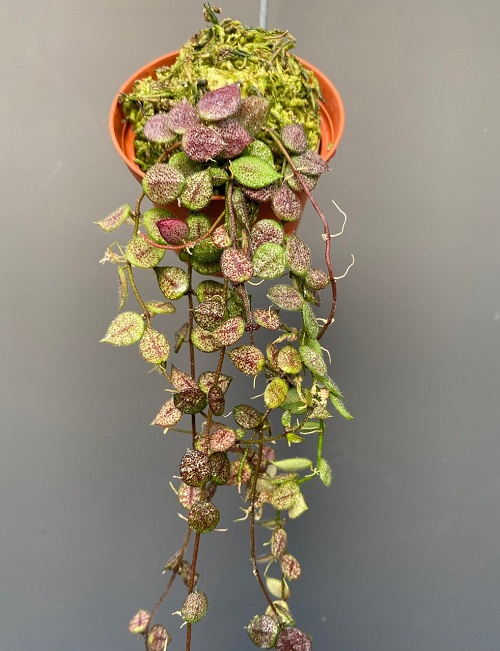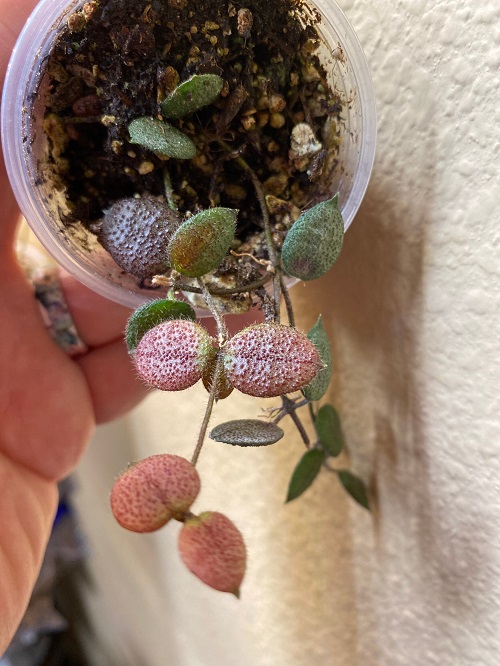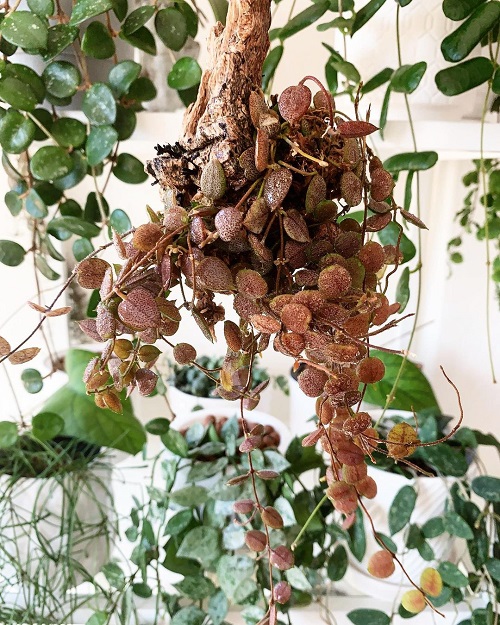Ideal for low-light homes, Growing Dischidia hirsuta ‘Red Leaf’ Indoors is worth the effort for the beautiful foliage it holds!

With attractive foliage dangling down, Dischidia hirsuta ‘Red Leaf’ is a sight to behold, especially in hanging baskets or cute pots on your work desk. Head on to this informative guide to learn some easy care tips to rear this beautiful Dischidia cultivar!
- Botanical Name: Dischidia hirsuta ‘Red Leaf’
- Popular as—Ant Plant
- Thrives in a temperature range of 40-80°F or 4-27°C
- Loves bright, indirect sunlight
- Toxic to pets and humans
What is Dischidia hirsuta ‘Red Leaf’?
Member of the Apocynaceae family, Dischidia hirsuta Red Leaf is an attractive epiphyte, prized for its unique succulent leaves, round in shape with pointed tips. The fleshy, thick foliage is loaded with a high amount of anthocyanin, resulting in the exotic red pigment and tiny bumps on the surface that makes this rare cultivar a favorite of plant parents. Small yellow to orange flowers grace the beautiful vines in the warmer months.
Learn about Growing Dischidia Ovata Indoors here
Ideal Pot Size
Dischidia hirsuta ‘Red Leaf’ accommodates itself pretty well in small containers. You can start this ornamental vine in 6-8 inches pots with enough drainage holes. Big glasses, giant coffee mugs, or pretty ceramics will do justice to this gorgeous specimen. The beautiful vines can also liven vertical wall planters, hanging baskets, or a corner by your favorite books!
Dischidia hirsuta ‘Red Leaf’ Propagation

The easiest way to propagate Dischidia hirsuta ‘Red Leaf’ is through stem cuttings, so all you need is a healthy vine to multiply this beauty:
- Use sterilized clippers to snip a 4-6 inches long stem below the leaf node.
- Let the cutting callous over for a few hours in a dry, open place.
- Prepare a pot with a well-draining potting media and plant the cutting in it.
- Tap the soil firmly around the node and water it thoroughly.
- Keep the pot in dappled sunlight.
You’ll notice new growth in the next 2-4 weeks.
Want to Grow Dischidia ruscifolia Indoors? Click here
Dischidia hirsuta ‘Red Leaf’ Care

Light
Place your houseplant in a spot with indirect light, mimicking its native environment. An east or north-facing window will ensure 3-4 hours of filtered morning sunlight, ensuring the leaves don’t scorch in the afternoon sun while keeping up their attractive hues.
Soil
Red Leaf Dischidia variety thrives in a well-draining medium rich in organic content. The epiphytic roots of the plant do not appreciate regular potting soil. Get a mixture of shredded bark or sphagnum moss and coco coir for an ideal blend.
Alternatively, orchid potting media also works well for the plant.
Water
The vines grow best in a moist growing medium that is not soggy by any chance. To maintain the right moisture balance, follow a weekly deep watering session—saturate the medium thoroughly until excess water drains out. Let the top inch dry out before repeating. This will ensure the roots get enough moisture without pooling excess water at the bottom.
The frequency might vary depending on the weather conditions. Keep the medium on the drier side during the plant’s dormancy in winter.
Temperature and Humidity
Dischidia hirsuta Red Leaf prefers warmer environments and grows best in a temperature range of 40-80°F or 4-27°C. The plant loves humid conditions, so displaying it over your bathroom shelf can be an apt choice. To compensate for the drier days, a pebble tray or humidifier can be useful.
You may also group it with other humidity-loving houseplants to create a humid micro-climate.
Fertilizer
The plant does not require much fertilization if grown in a nutrient-rich medium. However, half-strength doses of liquid fertilizer at the beginning of Spring and Summer can boost its growth. Feed the plant every 4-6 weeks in the warmer month and reduce the frequency to every 8-10 weeks as the days start getting colder.
Flush the pot with water thoroughly to prevent salt build-up in the medium.
Major Troubleshooting Tips
Growing Dischidia hirsuta ‘Red Leaf’ Indoors is a rewarding experience but comes with its specific set of challenges. The most common ones include:
- Yellowing Leaves: Majorly a sign of overwatering or inadequate lighting. Ensure it receives ample indirect light, and adjust your watering schedule to let the topsoil dry out between waterings.
- Wilted or Shriveled Leaves: This issue may be due to underwatering or low humidity. Check the soil moisture and water the plant if necessary. To increase humidity, place a tray with water and pebbles under the pot, or use a humidifier in the room.
- Leaf Drop: Can be caused by sudden temperature changes, drafts, or stress. Maintain consistent room temperature and keep the plant away from direct heat sources, air vents, or cold drafts.
- Pests: Inspect your Dischidia hirsuta red leaf for pests such as mealybugs, aphids, or spider mites. To treat infestations, use insecticidal soap or neem oil, and remove any visibly affected leaves.
- Slow Growth: Happens mostly due to insufficient nutrients. Fertilize your plant with a balanced liquid fertilizer, diluted to half strength, during the growing season, every 4-6 weeks.
- Leggy Growth: Leggy growth may be caused by insufficient light. Move your plant to a brighter location with indirect sunlight to promote compact and healthy growth.
Where to Buy Dischidia hirsuta ‘Red Leaf’?
To purchase this striking plant, visit your local nurseries or garden centers, as they often carry a diverse range of exotic and rare plants. Alternatively, you can explore reputable online plant retailers and marketplaces such as Etsy, eBay, or Facebook Marketplace, which might acquire Dischidia hirsuta Red Leaf for Sale. Y
ou can find specialized sellers offering a wide selection of rare and sought-after plants, including this Dischidia variety. Always ensure to check seller reviews and confirm their shipping practices to guarantee you receive a healthy and well-cared-for plant.







